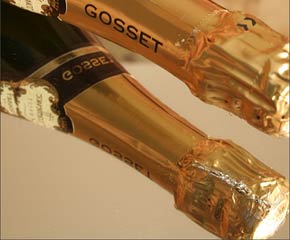European Union labelling rules forbid them from calling it champagne. They don’t make enough of it to export and can barely keep up with domestic demand. But they are making some award-winning sparkling wines that rival many of the non-vintages made just across the Channel in France.
The chalky soil of Sussex and Kent – think White Cliffs of Dover – is part of the same geologic formation as France’s Champagne region. And the grapes used to produce Champagne – Chardonnay, Pinot Noir and Pinot Meunier – thrive in chalky soil.
“We’re only 80 miles or so from Champagne and the climate here is getting closer to that of Champagne. I think the French are actually concerned,” said Eric Heerema, the 46-year-old Dutchman, who owns Nyetimber Wines.
Nyetimber’s 1998 won a gold and its 1999 Classic Cuvee took a silver medal at the International Wine and Spirit Competition.
Just as in the Champagne region, which saw a 2006 harvest that brought in the maximum allowable yields, last summer’s growing season helped Nyetimber and most of the 400 or so other UK wineries produce a bumper crop. But despite the increase in volume, the entire UK wine industry will produce about two million bottles.
“We don’t export it. We don’t make enough to meet domestic demand,” said Julia Trustam Eve, a spokeswoman for the English Wine Producers. Her industry group is hoping that by 2015, the English wine industry will be producing 5.5 million bottles.
France’s Champagne region alone produces between 250 million and 300 million bottles annually. That means that English sparklers have what many wine aficionados seek: rarity, taste, and, if you live in the UK, value.
If you can find a bottle of Nyetimber’s 2000 Premiere Curvee, it will cost about 22 pounds ($43.70) in Britain. A comparable bottle of Lanson’s Black Label NV, to which it is compared by British wine critics, goes for about 25 pounds.
“We produced 60,000 bottles and have already sold out,” said Heerema. Now he faces a problem many producers only dream about: how to keep up with demand for his pale gold liquid that has a crisp clean taste and tight bubbles.
This year Nyetimber will plant an additional 70 acres of vines to go with the 194 acres already under cultivation. But the results will not be bottled – or flow to the bottom line – for another four years at the earliest.
“We’re resorting to rationing,” he said, adding that he hoped to produce 500,000 bottles in four to five years.
One of his fellow vintners, nearby RidgeView, which began sales in 2000, is having a similar problem. Also an award winning winery, (RidgeView’s Merret Bloomsbury 2003 took the silver medal in the International Wine and Spirit Competition and the 2002 took a gold) is producing about 60,000 bottles of its effervescent, elegant sparklers this year. They, too, are almost completely sold out. If you can find their 2003, expect to pay about 18 pounds
Despite the tight supply, England’s wineries are hoping to boost awareness and give their wine tourism cottage industry a boost later this month when they host English Wine Week

